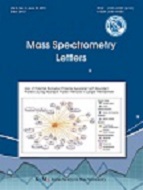
- P-ISSN 2233-4203
- E-ISSN 2093-8950

In this study, we explored a new approach for generating ions of organics and biomolecules using contactless atmosphericpressure ionization (C-API). That is, a tapered capillary (~20 cm) was connected to a syringe, which was coupled to asyringe pump for providing a given flow rate to introduce sample solution to the proximity of a mass spectrometer. The gasphase ions derived from analytes were readily formed in the capillary outlet, which was very close to the mass spectrometer(~1 mm). No external electric connection was applied on the capillary emitter. This setup is very simple, but it can function as anion source. This approach can be readily used for the analysis of small molecules such as amino acids and large molecules suchas peptides and proteins. The limit of the detection of this approach was estimated to be ~10 pM when using bradykinin as thesample. Thus, we believe that this approach should be very useful for being used as an alternative ion source because of its lowcost, high sensitivity, simplicity, and ease of operation.
Fenn, J. B. (1989). . Science, 246, 61-.
Emmett, M. R. (1995). . J. Neurosci. Methods, 62, 141-.
Wilm, M. (1996). . Anal. Chem, 68, 1-.
Takáts, Z. (2004). . Science, 306, 471-.
Takáts, Z. (2005). . J. Mass Spectrom, 40, 1261-.
Miao, Z. (2011). . Anal. Chem, 83, 3994-.
Laskin, J. (2012). . Anal. Chem, 84, 141-.
Zhu, L. (2008). . Rapid Commun. Mass Spectrom, 22, 2993-.
McCullough, B. J. (2011). . Rapid Commun. Mass Spectrom, 25, 1445-.
Cheng, C-.Y. (2008). . Anal. Chem, 80, 7699-.
Harper, J. D. (2008). . Anal. Chem, 80, 9097-.
Santos, V. G. (2011). . Anal. Chem, 83, 1375-.
Chen, T.-Y. (2010). . Chem. Commun, 46, 8347-.
Chen, T.-Y. (2010). . J. Am. Soc. Mass Spectrom, 21, 1547-.
Lo, T.-J. (2012). . J. Mass Spectrom, 47, 480-.
Hirabayashi, A. (1995). . Anal. Chem, 67, 2878-.
Dams, R. (2002). . Anal. Chem, 74, 3206-.
Haddad, R. (2008). . Anal. Chem, 80, 2744-.
Cody, R. B. (2005). . Anal. Chem, 77, 2297-.
Sampson, J. S. (2006). . J. Am. Soc. Mass Spectrom, 17, 1712-.
Nemes, P. (2007). . Anal. Chem, 79, 8098-.
Haapala, M. (2007). . Anal. Chem, 79, 7867-.
Trimpin, S. (2009). . Mol. Cell Proteom, 9, 362-.
Weston, D. J. (2010). . Analyst, 135, 661-.
Huang, M.-Z. (2010). . Annu. Rev. Anal. Chem, 3, 43-.
Alberici, R. M. (2010). . Anal. Bioanal. Chem, 398, 265-.
Xiaoxiao, M. (2012). . TRAC-Trend Anal. Chem, 35, 50-.
McEwen, C. N. (2005). . Anal. Chem, 77, 7826-.
McEwen, C. N. (2007). . J. Am. Soc. Mass Spectrom, 18, 1274-.
Hsieh, C.-H. (2011). . Anal. Chem, 83, 2866-.
Hsieh, C.-H. (2012). . J. Mass Spectrom, 47, 586-.